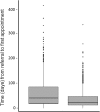A model of access combining triage with initial management reduced waiting time for community outpatient services: a stepped wedge cluster randomised controlled trial
- PMID: 30336784
- PMCID: PMC6194740
- DOI: 10.1186/s12916-018-1170-z
A model of access combining triage with initial management reduced waiting time for community outpatient services: a stepped wedge cluster randomised controlled trial
Abstract
Background: Long waiting times are associated with public community outpatient health services. This trial aimed to determine if a new model of care based on evidence-based strategies that improved patient flow in two small pilot trials could be used to reduce waiting time across a variety of services. The key principle of the Specific Timely Appointments for Triage (STAT) model is that patients are booked directly into protected assessment appointments and triage is combined with initial management as an alternative to a waiting list and triage system.
Methods: A stepped wedge cluster randomised controlled trial was conducted between October 2015 and March 2017, involving 3116 patients at eight sites across a major Australian metropolitan health network.
Results: The intervention reduced waiting time to first appointment by 33.8% (IRR = 0.663, 95% CI 0.516 to 0.852, P = 0.001). Median waiting time decreased from a median of 42 days (IQR 19 to 86) in the control period to a median of 24 days (IQR 13 to 48) in the intervention period. A substantial reduction in variability was also noted. The model did not impact on most secondary outcomes, including time to second appointment, likelihood of discharge by 12 weeks and number of appointments provided, but was associated with a small increase in the rate of missed appointments.
Conclusions: Broad-scale implementation of a model of access and triage that combined triage with initial management and actively managed the relationship between supply and demand achieved substantial reductions in waiting time without adversely impacting on other aspects of care. The reductions in waiting time are likely to have been driven, primarily, by substantial reductions for those patients previously considered low priority.
Trial registration: Australian New Zealand Clinical Trials Registry ACTRN12615001016527 registration date: 29/09/2015.
Keywords: Access; Appointments and schedules; Community health; Outpatients; Waiting lists.
Conflict of interest statement
Ethics approval and consent to participate
The trial was approved by the Eastern Health Human Research Ethics Committee (E06-2014). Managers of each site (cluster) provided consent to participate on behalf of their service. A waiver of consent was granted for use of routinely collected health service data.
Consent for publication
Not applicable.
Competing interests
The authors declare that they have no competing interests.
Publisher’s Note
Springer Nature remains neutral with regard to jurisdictional claims in published maps and institutional affiliations.
Figures


Similar articles
-
Sustainable waiting time reductions after introducing the STAT model for access and triage: 12-month follow up of a stepped wedge cluster randomised controlled trial.BMC Health Serv Res. 2020 Oct 21;20(1):968. doi: 10.1186/s12913-020-05824-z. BMC Health Serv Res. 2020. PMID: 33087110 Free PMC article. Clinical Trial.
-
Improving access for community health and sub-acute outpatient services: protocol for a stepped wedge cluster randomised controlled trial.BMC Health Serv Res. 2016 Aug 9;16(a):364. doi: 10.1186/s12913-016-1611-3. BMC Health Serv Res. 2016. PMID: 27506923 Free PMC article. Clinical Trial.
-
Staff perspectives of a model of access and triage for reducing waiting time in ambulatory services: a qualitative study.BMC Health Serv Res. 2019 May 3;19(1):283. doi: 10.1186/s12913-019-4123-0. BMC Health Serv Res. 2019. PMID: 31053118 Free PMC article.
-
[Waiting lists: case management and an alternative reimbursement paradigm].Ig Sanita Pubbl. 2003 Nov-Dec;59(6):393-412. Ig Sanita Pubbl. 2003. PMID: 15116151 Review. Italian.
-
Reducing wait time from referral to first visit for community outpatient services may contribute to better health outcomes: a systematic review.BMC Health Serv Res. 2018 Nov 20;18(1):869. doi: 10.1186/s12913-018-3669-6. BMC Health Serv Res. 2018. PMID: 30458761 Free PMC article.
Cited by
-
Sustainable waiting time reductions after introducing the STAT model for access and triage: 12-month follow up of a stepped wedge cluster randomised controlled trial.BMC Health Serv Res. 2020 Oct 21;20(1):968. doi: 10.1186/s12913-020-05824-z. BMC Health Serv Res. 2020. PMID: 33087110 Free PMC article. Clinical Trial.
-
A Multi-Faceted Strategy for Evidence Translation Reduces Healthcare Waiting Time: A Mixed Methods Study Using the RE-AIM Framework.Front Rehabil Sci. 2021 Mar 23;2:638602. doi: 10.3389/fresc.2021.638602. eCollection 2021. Front Rehabil Sci. 2021. PMID: 36188815 Free PMC article.
-
The Emergency nurse Protocols Initiating Care-Sydney Triage to Admission Risk Tool (EPIC-START) trial: protocol for a stepped wedge implementation trial.Implement Sci Commun. 2023 Jun 20;4(1):70. doi: 10.1186/s43058-023-00452-0. Implement Sci Commun. 2023. PMID: 37340486 Free PMC article.
-
Sustainability of an intervention to reduce waiting for access to an epilepsy outpatient clinic.Heliyon. 2023 Dec 10;10(1):e23346. doi: 10.1016/j.heliyon.2023.e23346. eCollection 2024 Jan 15. Heliyon. 2023. PMID: 38169770 Free PMC article.
-
Service-level interventions to reduce waiting time in outpatient and community health settings may be sustained: a systematic review.BMJ Open Qual. 2025 Mar 7;14(1):e003235. doi: 10.1136/bmjoq-2024-003235. BMJ Open Qual. 2025. PMID: 40054995 Free PMC article.
References
Publication types
MeSH terms
Associated data
LinkOut - more resources
Full Text Sources

